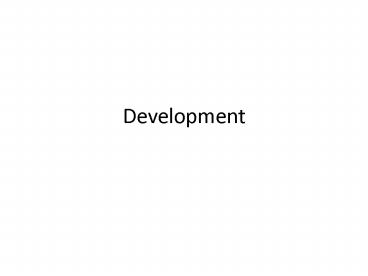Development PowerPoint PPT Presentation
1 / 16
Title: Development
1
Development
2
- Development
- Control involves
- zygote genome
- cytoplasmic determinants molecules in the egg
- Cell differentiation is the specialization of
cells in structure and function - Morphogenesis is the process by which an animal
takes shape
3
- Fertilization brings the haploid nuclei of sperm
and egg together, forming a diploid zygote - Control factors regulate/prevent
- Interspecific egg-sperm fusion
- polyspermy
- Events following fertilization
- Cleavage cell division creates a hollow ball of
cells called a blastula - Gastrulation cells are rearranged into a
three-layered gastrula - Organogenesis the three layers interact and move
to give rise to organs
4
- Fertilization control factors
- Sperm-egg specificity interaction of acrosomal
proteins with cell surface receptors on egg - Prevention of Polyspermy development of
- Fast block changes in membrane potential
(depolarization) not in mammals - Slow block removal of sperm-binding receptors
5
- Fertilization in mammals and other terrestrial
animals is internal - In mammalian fertilization, the cortical reaction
modifies the zona pellucida, the extracellular
matrix of the egg, as a slow block to polyspermy
6
- Cleavage ? Blastula
- Cleavage rapid mitotic division w/o increase in
cell size - Cleavage partitions the cytoplasm of one large
cell into many smaller cells called blastomeres - The blastula is a ball of cells with a
fluid-filled cavity called a blastocoel
7
- Cleavage planes usually follow a pattern that is
determined by polarity - polarity is defined by distribution of yolk
(stored nutrients) - - more significant in birds, reptiles, minimal in
mammals - vegetal pole has more yolk
- animal pole has less yolk
8
- Meroblastic cleavage, incomplete division of the
egg, occurs in species with yolk-rich eggs, such
as reptiles and birds - Holoblastic cleavage, complete division of the
egg, occurs in species whose eggs have little or
moderate amounts of yolk, such as sea urchins and
frogs
9
- Gastrulation (deuterostome development)
- Rearrangement of blastula into a three-layered
embryo Grastula - embryonic germ layers
- The ectoderm forms the outer layer
- The endoderm lines the digestive tract
- The mesoderm partly fills the space between the
endoderm and ectoderm
Sea Urchin
10
- Organogenesis ? various regions of the germ
layers develop into rudimentary organs
11
- Early in vertebrate organogenesis, the notochord
forms from mesoderm, and the neural plate forms
from ectoderm - Neural plate ? neural tube ? CNS
12
- Neural crest cells band of cells along borders
of neural tube - Were mesoderm cells
- various other organs/tissues teeth, some bone
cartil. of skull, dermis in face, sensory (eyes) - Condensation of cell block give rise to somites
- Some somite cells become mesenchymal (migrate) to
give rise to muscle and cartilage associated with
vertebral column
13
- Lateral to the somites, the mesoderm splits to
form the coelom (fig. 32.8)
14
- Mammals
- The eggs of placental mammals
- Are small and store few nutrients
- Exhibit holoblastic cleavage
- Show no obvious polarity
- Gastrulation and organogenesis resemble the
processes in birds and other reptiles - Early cleavage is relatively slow in humans and
other mammals
15
- Cells in a multicellular organism share the same
genome - Differences in cell types is the result of
differentiation, the expression of different
genes - Two general principles underlie differentiation
- During early cleavage divisions, embryonic cells
must become different from one another - If the eggs cytoplasm is heterogenous, dividing
cells vary in the cytoplasmic determinants they
contain - After cell asymmetries are set up, interactions
among embryonic cells influence their fate,
usually causing changes in gene expression - This mechanism is called induction, and is
mediated by diffusible chemicals or cell-cell
interactions
16
- Signal molecules produced by inducing cells
influence gene expression in cells receiving them - Signal molecules lead to differentiation and the
development of particular structures - Hox genes also play roles during limb pattern
formation

